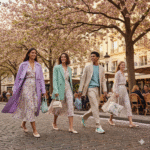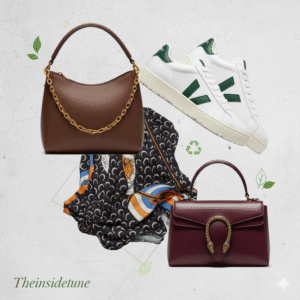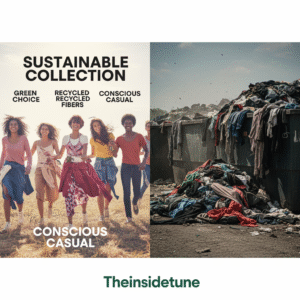Intersection of Policy, Activism & Fashion in Europe 2025; From Runways to Regulations, How Activism is Shaping European Fashion
Introduction: Fashion Beyond Aesthetic
Fashion has always been more than just fabric stitched into trends. In Europe especially, what we wear has long been tied to the movements, policies, and voices that shape our societies. Clothes are not just about style; they are a language—sometimes subtle, sometimes loud—that reflects who we are, what we stand for, and the battles we’re willing to fight.
Think about it: from the suffragettes wearing white dresses as a symbol of purity and defiance, to today’s climate activists staging runway protests, fashion has always mirrored activism and politics. In recent years, this link has grown stronger than ever. Europe, with its progressive policies and rich history of social movements, is leading the way in showing how activism and government regulation are reshaping the fashion industry.
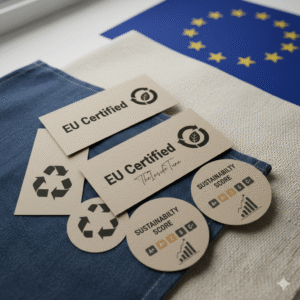
What’s happening today is different. It’s not just about fleeting trends; it’s about long-term change. Sustainability policies from the EU, activist-led boycotts of fast fashion, and demands for inclusivity are forcing brands to rethink how they design, produce, and present their collections. Fashion weeks in Paris, Milan, London, and Copenhagen are no longer just glamorous showcases—they are platforms where politics, activism, and creativity meet.
In other words, the runway is no longer neutral. Every fabric, every stitch, and every slogan tee carries a message. And in Europe, those messages are becoming louder and clearer.
Historical Glimpses: When Policy Shaped Fashion 👗📜
Before diving into today’s activism-driven runways, it’s worth pausing to see how fashion has always been influenced by politics and policies in Europe. History shows us that style has never existed in isolation—it bends, adapts, and transforms with the world around it.
🔹 WWII & Rationing Fashion
During World War II, fabric rationing meant designers had to think smarter, not bigger. Extravagant gowns gave way to practical cuts, minimalistic silhouettes, and shorter hemlines. What started as necessity soon became a style of its own—proof that policy can literally reshape wardrobes.
🔹 EU Textile Regulations in the 20th Century
Fast forward to post-war Europe: new regulations around textiles and imports pushed designers and brands to rethink materials and production. These laws didn’t just impact factories—they influenced what ended up on shop racks and in closets.
🔹 Protest Aesthetics of the 1960s & 1970s ✊
In the late 20th century, European youth movements turned fashion into a loudspeaker. Students protesting for freedom, gender equality, and workers’ rights embraced denim, unisex looks, and bold prints. Clothing became a badge of rebellion—a way to show which side you were on without saying a word.
The message is clear: whenever Europe faced social or political upheaval, fashion shifted too. What people wore wasn’t just about looking good—it was about survival, resistance, and solidarity. And that same spirit still shapes the runway today.
Sustainability Policies & the Rise of Eco-Fashion 🌱👠
If there’s one thing reshaping European fashion today, it’s sustainability. Once considered a “nice extra,” it has now become a non-negotiable part of the industry—driven by both EU policy and the passionate voices of activists. This is where politics and style meet head-on.
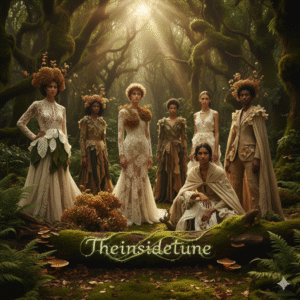
🌍 The EU Green Deal & Fashion’s New Rules
Europe’s ambitious Green Deal, which aims to make the continent climate-neutral by 2050, has placed the fashion industry under the spotlight. Why? Because fashion is one of the most polluting industries on the planet. From toxic dyeing processes to massive textile waste, it’s clear that the old way of producing clothes won’t survive in a greener Europe.
This shift has birthed strict new policies, such as the EU Strategy for Sustainable and Circular Textiles (2022), which targets:
-
Longer-lasting clothing 👗
-
Easier recycling ♻️
-
Reduced microplastic pollution 🌊
-
Traceable supply chains 🔍
Brands that don’t keep up risk fines, bans, or—worse—losing consumers who are increasingly eco-conscious.
♻️ The Circular Economy in Action
Gone are the days when clothing was disposable. The EU is pushing for a circular economy, where clothes are designed to be recycled, repurposed, or resold. This is why resale and rental platforms like Vinted, Vestiaire Collective, and By Rotation are booming across Europe. Shoppers now see second-hand as chic, not shameful.
👗 Designers Leading the Eco-Revolution
Activism meets policy on the runway too. Designers across Europe are embracing eco-fashion as both an ethical and creative challenge:
-
Stella McCartney has long championed cruelty-free fashion and is actively lobbying EU policymakers to toughen sustainability laws.
-
Veja (France) turned sneakers into a sustainability statement with organic cotton, fair trade rubber, and complete transparency.
-
Scandinavian brands like Ganni and Filippa K are experimenting with rental models and upcycled collections, proving eco-fashion can also be stylish and modern.
🔥 Activism Meets Style
This isn’t just about top-down policies. Movements like Fridays for Future and Extinction Rebellion have staged protests at fashion weeks, demanding that brands take responsibility for their environmental impact. Activists have even interrupted runway shows in Paris and London, turning high fashion into a battleground for climate justice.
💡 A Cultural Shift in Europe
Eco-fashion is no longer just a trend—it’s a cultural expectation. Young Europeans, especially Gen Z, see sustainable shopping as a lifestyle choice. They’re demanding transparency with hashtags like #WhoMadeMyClothes, pushing brands to reveal their supply chain secrets. In short, it’s not enough for a dress to look good—it needs to do good too.
🌱 In Europe today, sustainability is not optional—it’s survival. The fusion of policy pressure, consumer activism, and designer innovation is rewriting the rules of style. Eco-fashion isn’t just reshaping wardrobes—it’s reshaping the very identity of the European fashion industry.
Activism as a Fashion Driver ✊👚🌈
If sustainability policies are reshaping the industry from above, activism is reshaping fashion from the ground up. Europe has always been a hub of social movements, and today’s activists are using fashion not just as clothing—but as a megaphone for their causes. From climate change to body positivity, feminism to LGBTQ+ rights, activism is driving the trends we see on the streets and the runways.
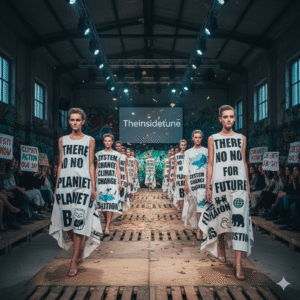
🌍 Climate Activism on the Runway
Movements like Fridays for Future and Extinction Rebellion have made fashion part of their protest culture. They don’t just march in the streets—they disrupt fashion weeks in London, Paris, and Milan to demand an end to overproduction and waste. Designers are listening: more collections now feature upcycled fabrics, protest-inspired prints, and slogans about saving the planet. Fashion is becoming climate-conscious not just because of policy, but because activists are forcing it into the spotlight.
💪 Feminist Voices in Fashion
Feminist activism has had a huge influence on fashion’s visual language. From suffragette white dresses in history to modern slogan tees declaring “We Should All Be Feminists” (popularized by Dior), clothing has become a banner of empowerment. European runways increasingly showcase strong silhouettes, sharp tailoring, and collections that celebrate women’s agency. Activism has transformed femininity in fashion from fragile to fierce.
🌈 LGBTQ+ and Inclusivity Movements
The LGBTQ+ movement has brought gender-fluid, non-binary, and androgynous fashion into mainstream European style. Pride collections have become a seasonal norm, but beyond the rainbow merch, real change is happening: brands like Gucci, Balenciaga, and young independent designers are breaking traditional gender codes. Models of diverse identities are walking major runways, challenging the industry’s old norms of beauty. Inclusivity is no longer a “special edition”—it’s becoming the default.
🧍 Body Positivity and Diversity Activism
Another activism-driven change is the body positivity movement. Once dominated by impossible beauty standards, European fashion is finally opening up to plus-size, differently-abled, and older models. Campaigns like Dove’s “Real Beauty” and independent labels that celebrate all body types are challenging the thin-only aesthetic. On runways and in campaigns, diversity isn’t just a buzzword anymore—it’s an activist demand the industry can’t ignore.
🔥 Fashion today is a battlefield of ideas. Activists are no longer waiting for brands to act—they are pushing them to change. Every march, every protest, every viral hashtag (#BodyPositivity, #WhoMadeMyClothes, #LoveIsLove) leaves its mark on the fabric of fashion. And in Europe, where activism is deeply woven into cultural identity, the industry cannot help but reflect these voices.
European Fashion Weeks Under Policy Pressure 👠🎭
Fashion weeks in Europe are no longer just glamorous showcases of luxury and creativity. Today, they’re political stages where the pressure of policy and the fire of activism meet. Paris, Milan, London, and Copenhagen—the four powerhouses of European fashion—are being reshaped by new sustainability laws, activist protests, and consumer expectations. The result? Fashion weeks have become less about extravagance and more about accountability.

🇫🇷 Paris Fashion Week: Luxury Meets Activism
Paris, the crown jewel of European fashion, has faced some of the most high-profile activist interventions. Climate protesters have stormed runways, holding banners that call out overproduction and waste. Luxury houses like Chanel and Dior are responding with sustainability pledges, more eco-friendly fabrics, and even activism-inspired collections. The French government’s strict climate goals add another layer of pressure, forcing Paris Fashion Week to balance artistry with environmental responsibility.
🇮🇹 Milan Fashion Week: Tradition Under Scrutiny
Milan is known for glamour, excess, and tradition—but it’s under increasing scrutiny. Italian designers are being pushed to move away from fast fashion partnerships and towards transparency. Gucci’s fur ban set a precedent, while brands like Prada and Armani are experimenting with recycled materials. Activists in Milan often highlight the tension between Italy’s rich heritage of craftsmanship and the urgent need for sustainability. Policy changes in Italy’s textile sector are nudging even the most traditional houses toward greener practices.
🇬🇧 London Fashion Week: The Protest Capital
London has always been rebellious, and its fashion week reflects that spirit. Activists from groups like Extinction Rebellion have staged major protests, some even calling for London Fashion Week to be cancelled entirely due to fashion’s environmental toll. In response, designers here are some of the boldest when it comes to eco-fashion and inclusivity. Collections highlight recycled fabrics, gender-neutral cuts, and protest-inspired aesthetics. London is where activism feels like part of the runway itself.
🇩🇰 Copenhagen Fashion Week: The Sustainability Pioneer 🌱
If Paris is luxury and London is rebellion, Copenhagen is leadership. It’s the first fashion week in the world to adopt strict sustainability requirements for participating brands. Designers must meet eco-standards, from sourcing to production, or they won’t be allowed on the schedule. This bold move has made Copenhagen a global model for sustainable fashion weeks, proving that policy can be more than just theory—it can transform practice.
✨ The transformation of Europe’s fashion weeks shows a clear pattern: glamour is no longer enough. Runways are becoming political platforms, where designers, activists, and policymakers collide. What was once a stage for creativity alone is now a stage for accountability—and Europe is setting the tone for the world to follow.





